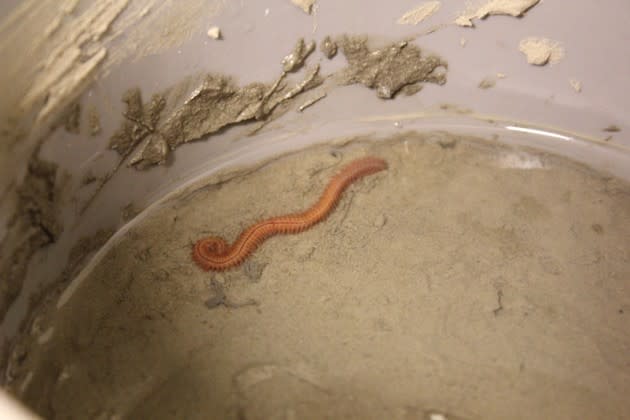Under the Sea in a Ragworm's Garden
Looking for a little hideaway beneath the waves? Until you find an octopus’s garden, maybe you can make do with a garden tended by a worm.
Hediste diversicolor, also known as the common ragworm, is a leggy marine critter about four inches long. It spends its one-to-three years of life burrowed below marshy coasts along the northern Atlantic, avoiding the animals that would like to eat it. The ragworm, in turn, feeds on whatever it can reach without leaving home. Sometimes it casts a delicate web of mucus across the opening to its burrow, waits a while, then eats the net along with any debris it’s caught. At other times the worm sticks its head out and yanks a blade of seagrass inside for a meal, or nabs a tiny passing animal with its jaws, or just nibbles some dirt.
Dining in lets H. diversicolor eat safely. But its usual diet, like that of a city dweller who relies on delivery for every meal, isn’t especially nutritious. Nitrogen is limited in these seafloor scraps, says Zhenchang Zhu, a Ph.D. student at the Royal Netherlands Institute for Sea Research. Does the creature have a trick for staying healthy?
Recommended: Trump’s Dakota Access Pipeline Memo: What We Know Right Now
Zhu and other researchers noticed that ragworms and their close relatives sometimes drag seeds into their burrows, too. These seeds, which often belong to a coastal plant called cordgrass, are like the city dweller’s CSA box. They arrive packed with nutrients to feed the plants that will grow from them. Maybe the worms were eating the cordgrass seeds, researchers thought—but no one had seen this happening. Zhu wondered if instead, the seeds might be a sneakier food source for the worm. Maybe, below ground, each ragworm was tending a garden.

For a recent study in Ecology, Zhu and his coauthors brought a few dozen ragworms into the lab and created cozy habitats for them. They sprinkled the muddy underwater surfaces of these habitats with cordgrass seeds, some already sprouted and some dead. A whole cordgrass seed is nearly two centimeters long—hefty compared to a ragworm’s body.
Recommended: A Day With the Women Scientists Protesting Trump
The scientists watched determined ragworms haul both unsprouted and sprouted seeds into their burrows. Three weeks later, the scientists sifted through the muck and discovered that every last sprout had been eaten. But all the unsprouted seeds were still intact. For such open-minded eaters, the ragworms had a marked distaste for seeds.
Ragworms usually buried these seeds a centimeter deep or less. This depth would allow the seeds to sprout, Zhu says. It might take weeks or months for a buried cordgrass seed to grow, depending on the season. But since ragworms stay in one burrow, a worm that planted a seed would still be there when it sprouted—and would be glad to eat that sprout.
To find out how nutritious this crop is, the scientists fed their ragworms a variety of diets in a separate experiment. Some worms got only the muddy sediment they lived in. Others had their mud periodically supplemented with a whole cordgrass seed, a seed with its hard husk removed, or a sprouted seed. A month later, worms eating sprouted seeds had gained significantly more weight than the worms stuck with whole seeds, who didn’t fare any better than the ones eating mud. The worms given de-husked seeds also gained a good amount of weight. So although the seed itself is nutritious, it seems the ragworms can’t crack it open without help. Sprouting the seed lets a worm unlock its nutrients.
Recommended: The Photo Details That Show the Truth About Inauguration Attendance
“Seeds were not directly edible for the worms” thanks to their size and tough coatings, Zhu says. But the sprouts are “juicy and soft” and “immediately edible.” Those sprouts are packed with protein and help the worms bulk up. In other studies, high-protein diets have boosted ragworms’ growth and reproduction.
Researchers haven’t counted how many sprouts the average worm grows, but Chu says that “potentially there could be many seeds buried inside the burrow.”
Rob Hughes, a marine biologist at Queen Mary University of London who has also studied ragworm feeding habits but wasn’t involved in the new research, calls the finding “quite interesting.” He points out, though, that a ragworm’s ability to eat a seed depends on its size. It’s possible that the worms in Zhu’s experiment were simply too small to get their mouths around the seeds, so perhaps smaller worms pull seeds into their burrows “without any gardening intent,” Hughes says, then find they can’t eat the seeds until they sprout.
If ragworms really are gathering seeds to grow, they’re more like hobbyist gardeners than full-time farmers. And that sets them apart from other farming animals, of which there are many. Ants and ambrosia beetles farm fungi for eating. Termites farm different fungi that help them break down the wood they eat. Marine snails scrape the flesh from marsh grasses, then eat the fungi that infect those wounds. Damselfish tend plots of their favorite algae, weeding them and defending them against other grazers.
All of these species rely on their gardens to eat, Chu says. But ragworms only grow food as a supplement to their usual diets, not a staple crop. That makes ragworm gardening one of a kind.
Octopuses, incidentally, don’t garden at all. Some pile up shells, stones, and refuse outside the entrances to their dens, creating the “garden” that’s really more of a garbage heap. If you’re hoping for a meal after all the singing and dancing around, you’re better off visiting the home of a ragworm.
Read more from The Atlantic:
This article was originally published on The Atlantic.
